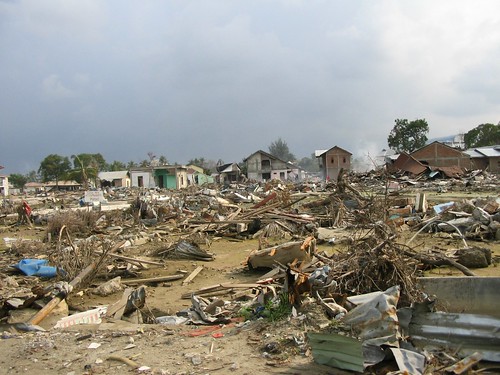 Did you know that tsunamis can travel up to 500 miles an hour, and build up to a height of 30 feet or more!? Tsunamis are caused by a disturbance underwater, usually by an earthquake, landslide, volcanic eruption, and/or the shifting of plates (causes earthquakes and landslides. Nearly 80% of the world tsunamis strike within the ring of fire. The ring of fire is located in the Pacific Ocean it covers 40,000 km (25,000 miles) in the shape of a horseshoe, The Ring of Fire has 452 volcanoes! In this report I am going to be talking about one of the methods for predicting tsunamis which is forecast modeling, the effects and destruction that tsunamis can cause, the warning systems for a tsunami, and lastly how to be safe in a tsunami.
Did you know that tsunamis can travel up to 500 miles an hour, and build up to a height of 30 feet or more!? Tsunamis are caused by a disturbance underwater, usually by an earthquake, landslide, volcanic eruption, and/or the shifting of plates (causes earthquakes and landslides. Nearly 80% of the world tsunamis strike within the ring of fire. The ring of fire is located in the Pacific Ocean it covers 40,000 km (25,000 miles) in the shape of a horseshoe, The Ring of Fire has 452 volcanoes! In this report I am going to be talking about one of the methods for predicting tsunamis which is forecast modeling, the effects and destruction that tsunamis can cause, the warning systems for a tsunami, and lastly how to be safe in a tsunami. Forecast Modeling:

Tsunamis don’t just cause tremendous life loss, they can also cause massive physical damage. Tsunamis have been known to destroy entire builds and left towns to looking like a nuclear war zone! Boats in the water have been hurled viciously to shore clicking the people on the boat and smashed them to bits! The landscape and environment is also widely affected by a tsunami. The force of it can spread hazardous chemicals and waste products to spread to new areas, poisoning marine life. Coral Reefs can also be affected, because the abrupt appearance of such a large amount of seiment can smother the floral reefs, many beaches are left without sand, and flora and fauna (such as trees etc…) can be killed as well.
Tsunami Warning Systems:
When an unannounced/unknown tsunami is about to hit, it seems vital to have a way to warn people. By having a warning system people are able to prevent the destruction of buildings and the amount of life loss. There are two warning systems when it comes to tsunamis one is the Regional Warning System (RWS) and the other is the International Warning System (IWS.) The Regional Warning System uses the local data for seismic waves in order to decide when the tsunami is going to occur. The International Warning System takes seismic data from other countries in order to determine when and if a tsunami is going to occur. When the tsunami is detected a series of sirens or alarms go off warning people of the arriving tsunami. 
Tsunami Safety and How to be Safe in a Tsunami: (Before)
1. Find out danger area
2. Know how high above sea level you are
3. Familizarize yourself with tsunami warning signs
4. Make sure you and your family members know how to respond properly to a tsunami
5. Know or make evacuation plans
6. Know how and when to turn of gas, electricity, and water
7. Have proper supplies at hand; flashlight and extra batteries, first aid kit, emergency food and water, essential medicines, cash and credit cards, sturdy shoes.
8. Develop emergency communication plan and have an emergency contact outside country.
During Tsunami:
1. Listen to radio and television for latest emergency information
2. If hear official tsunami warning or detect sign of a tsunami evacuate at once and climb to higher ground.
3. Stay away from beach
4. Stay out of area until advised to do otherwise by authorities (tsunamis are usually more than one wave.)
After a Tsunami:
1. Keep listening to latest emergency information.
2. Help injured or trapped people
3. If seriously injured person call for help do not try and move.
4. Stay away and out of damaged buildings.
5. When advised to return home do so immediately and enter with caution
6. Check food supply and test drinking water before drinking
7. Throw out food and water that could have been contaminated by flood water.
Over all I think that forecast sensors are the best way of detecting a tsunami however they don’t always work so knowing what to do and how to be safe in a tsunami is extremely important.
Bibliography/Works Sited:
Fuller,, Simon. "What Damages Do Tsunamis Cause? | EHow.com." EHow | How To Do Just About Everything! | How To Videos & Articles. 24 Nov. 2010. Web. 24 Feb. 2011.
INCIS. "Tsunami Modeling." Tsunami Modeling. Web. 24 Feb. 2011.
National Geographic. "Tsunami Facts, Tsunami Information, Tsunami Videos, Tsunami Photos - National Geographic." Environment Facts, Environment Science, Global Warming, Natural Disasters, Ecosystems, Green Living - National Geographic. Web. 24 Feb. 2011.
NOAA Center for Tsunami Research. "NOAA Tsunami - How Does the Tsunami Warning System Work?" Tsunami Warning System. Web. 24 Feb. 2011.
NOAA Center for Tsunami Research. "Tsunami Forecasting." NOAA Center for Tsunami Research. Web. 24 Feb. 2011.
NOAA Center for Tsunami Research. "Tsunami Modeling and Research." Tsunami Modeling and Research. Web. 24 Feb. 2011.
Organ Department of Geology and Mineral Industries. "Learn More about Tsunamis." Redirect - DOGAMI Home Page. Web. 24 Feb. 2011.
Palmer, Brian. "How Scientists Predict Tsunamis. - By Brian Palmer." Slate Magazine. 30 Sept. 2009. Web. 24 Feb. 2011.
Syzygyastro. "Warning Signs of Tsunamis."Web. 24 Feb. 2011.
Wikipedia. "Pacific Ring of Fire." Wikipedihttp://www.youtube.com/watch?v=0CJFt950vOka, the Free Encyclopedia. Web. 24 Feb. 2011.

No comments:
Post a Comment